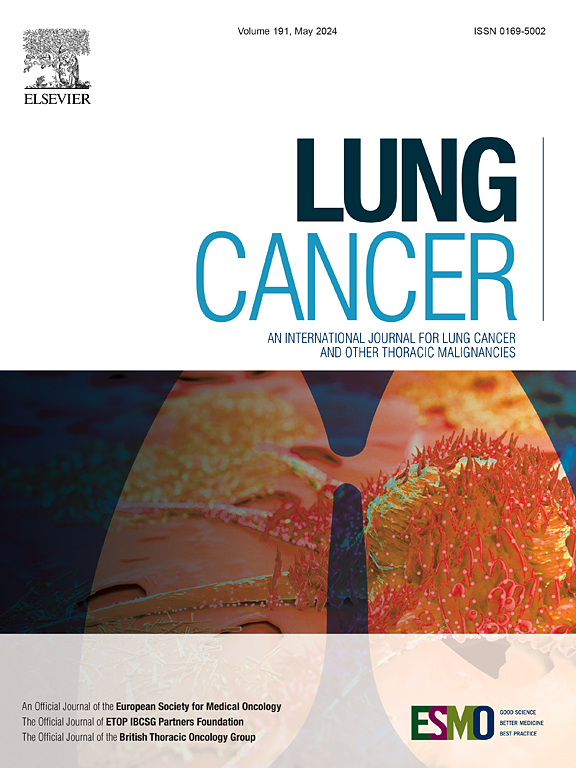一项前瞻性多机构研究,旨在验证机器人辅助胸腔镜手术与视频辅助胸腔镜手术治疗肺癌相比,术后疼痛是否无劣势:日本RATS兴趣小组01(J-RATSIG 01)
IF 4.5
2区 医学
Q1 ONCOLOGY
引用次数: 0
摘要
目的我们试图比较机器人辅助胸腔镜手术(RATS)和视频辅助胸腔镜手术(VATS)术后疼痛的最新数据,并明确肺癌患者术后疼痛与孔的数量或位置之间的关系。方法纳入通过 RATS 或 VATS 进行解剖性肺切除术且胸管在 7 天内拔除的患者。主要终点是术后第30天(POD30)数字评分量表(NRS)评分≤3分的患者比例。结果12家医疗机构共纳入455名患者(RATS,196人;VATS,209人)。VATS 组中有 99 名患者接受了单孔手术。在插入端口的平均数量(5.0 对 2.2)、受伤肋间部位的数量(2.9 对 1.9)、最大伤口大小(3.4 对 3.7 厘米)、手术时间(202 对 165 分钟)以及硬膜外麻醉或连续神经阻滞的使用率(45 对 31%)方面,RATS 组和 VATS 组之间存在显著差异。在RATS组和VATS组中,POD30的NRS≤3率分别为82.0%和94.7%(95%CI:-19.0%至-6.6%),无法证明非劣效性。结论 在日本微创胸腔镜手术的现状中,与 VATS 相比,RATS 需要更多的切口、更长的手术时间和更高的局部麻醉频率,在术后疼痛方面可能不如 VATS。本文章由计算机程序翻译,如有差异,请以英文原文为准。
A prospective multi-institutional study to verify the non-inferiority of postoperative pain in robot-assisted thoracic surgery in comparison with video-assisted thoracoscopic surgery for lung cancer: The Japanese RATS interest group 01 (J-RATSIG 01)
Objectives
We sought to compare the latest data on postoperative pain between robot-assisted thoracic surgery (RATS) and video-assisted thoracoscopic surgery (VATS), and to clarify the relationship between the number or placement of ports and postoperative pain in patients with lung cancer.
Methods
Patients who underwent anatomical lung resection by RATS or VATS and whose chest tube was removed within 7 days were enrolled. The primary endpoint was the percentage of patients with a numeric rating scale (NRS) score ≤ 3 on postoperative day 30 (POD30). The target sample size was 400 patients.
Results
Four hundred five patients (RATS, n = 196; VATS, n = 209) managed at 12 institutions were included. Ninety-nine patients in the VATS group underwent a uniport procedure. Significant differences were observed between the RATS and VATS groups in the mean number of inserted ports (5.0 vs. 2.2), number of injured intercostal sites (2.9 vs. 1.9), largest wound size (3.4 vs. 3.7 cm), operation time (202 vs. 165 min), and use of epidural anesthesia or continuous nerve block (45 vs. 31 %). In the RATS and VATS groups, the rates of NRS≤3 on POD30 were 82.0 % and 94.7 % (95 %CI: −19.0 to −6.6 %), respectively, which could not prove noninferiority. However, in a multivariable analysis, the RATS approach was not proven to be a significant risk factor.
Conclusion
In the current status of minimally invasive thoracic surgery in Japan, RATS involves a greater number of ports, longer operation time, and higher frequency of local anesthesia than VATS and may be inferior in terms of postoperative pain.
求助全文
通过发布文献求助,成功后即可免费获取论文全文。
去求助
来源期刊

Lung Cancer
医学-呼吸系统
CiteScore
9.40
自引率
3.80%
发文量
407
审稿时长
25 days
期刊介绍:
Lung Cancer is an international publication covering the clinical, translational and basic science of malignancies of the lung and chest region.Original research articles, early reports, review articles, editorials and correspondence covering the prevention, epidemiology and etiology, basic biology, pathology, clinical assessment, surgery, chemotherapy, radiotherapy, combined treatment modalities, other treatment modalities and outcomes of lung cancer are welcome.
 求助内容:
求助内容: 应助结果提醒方式:
应助结果提醒方式:


